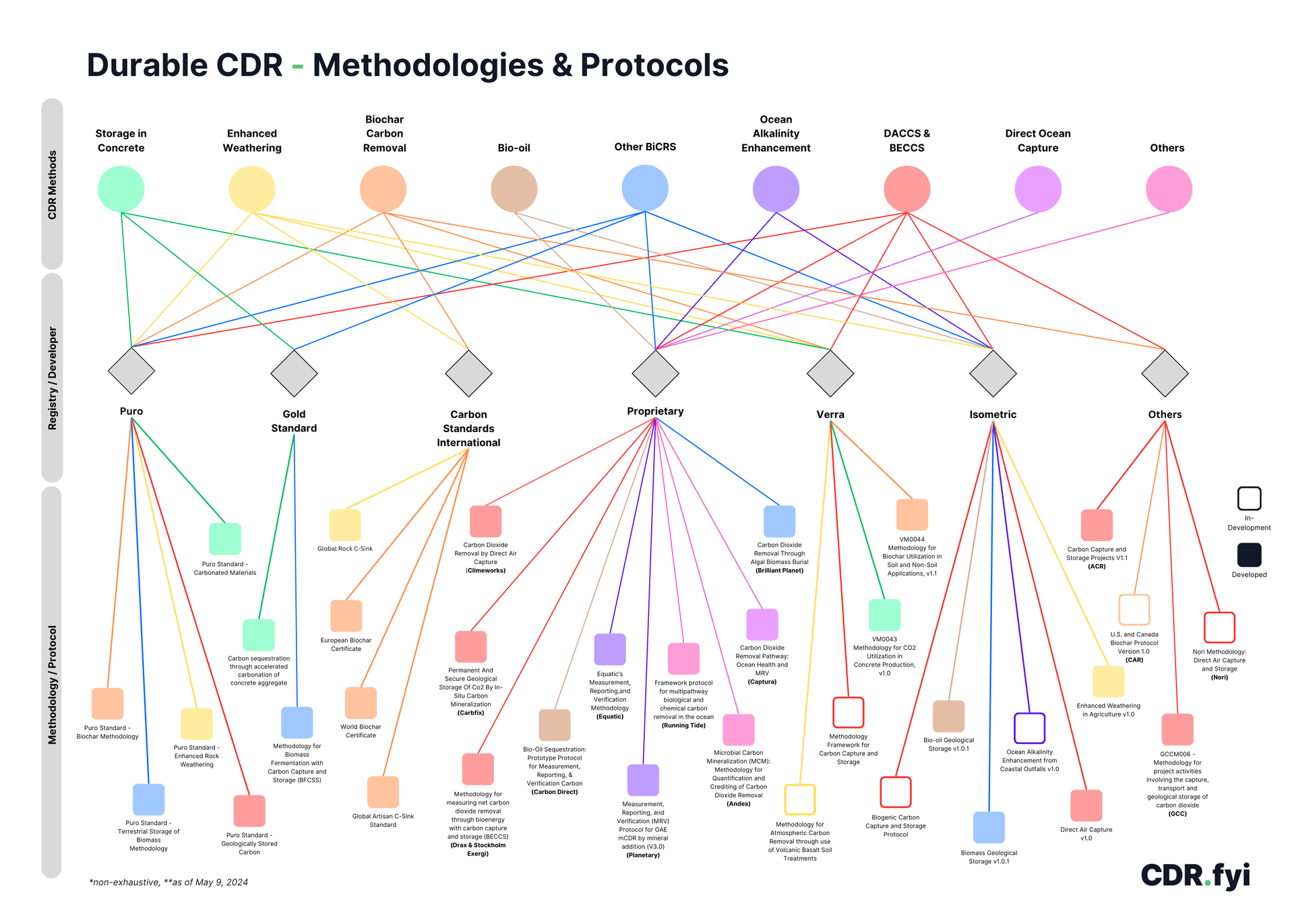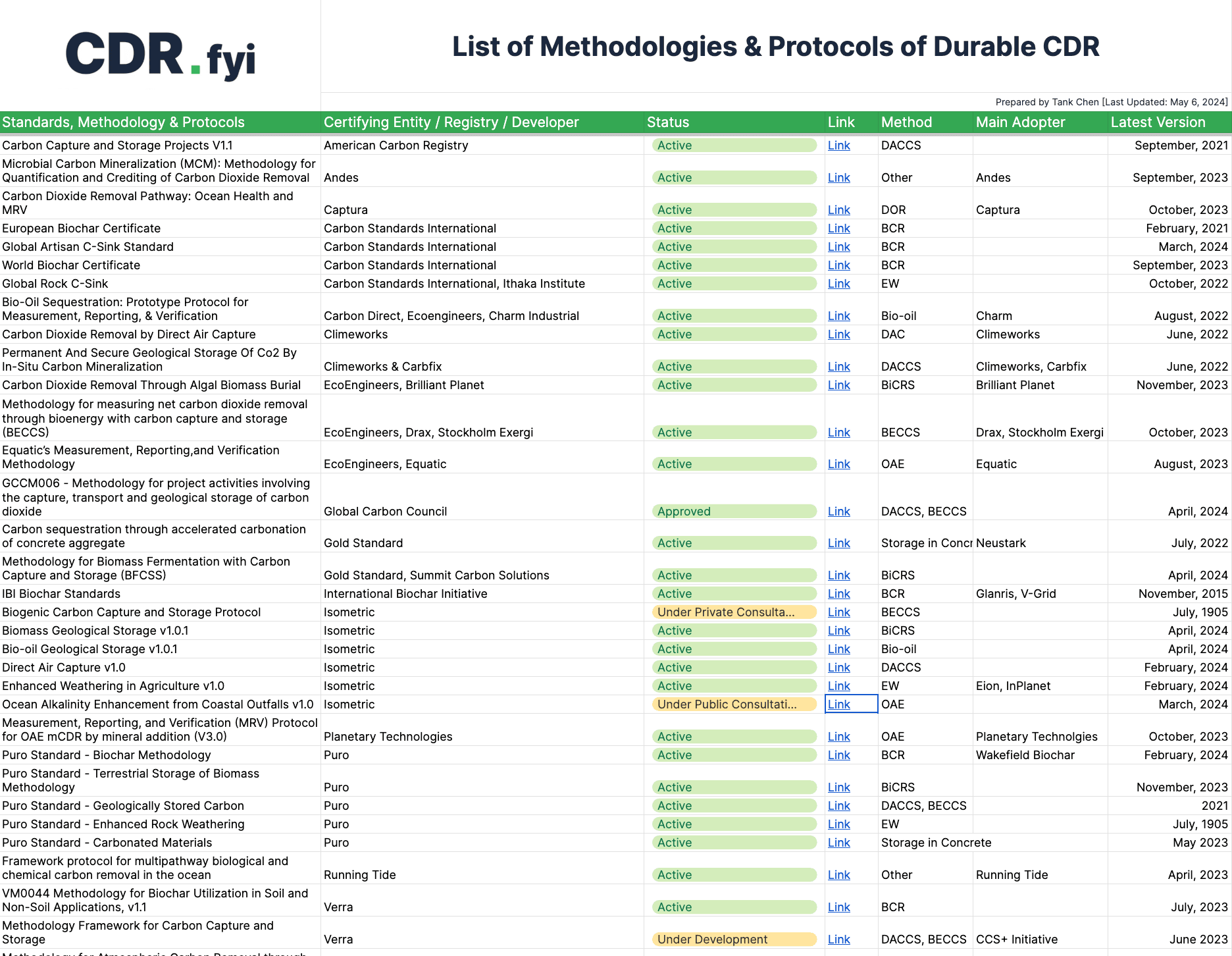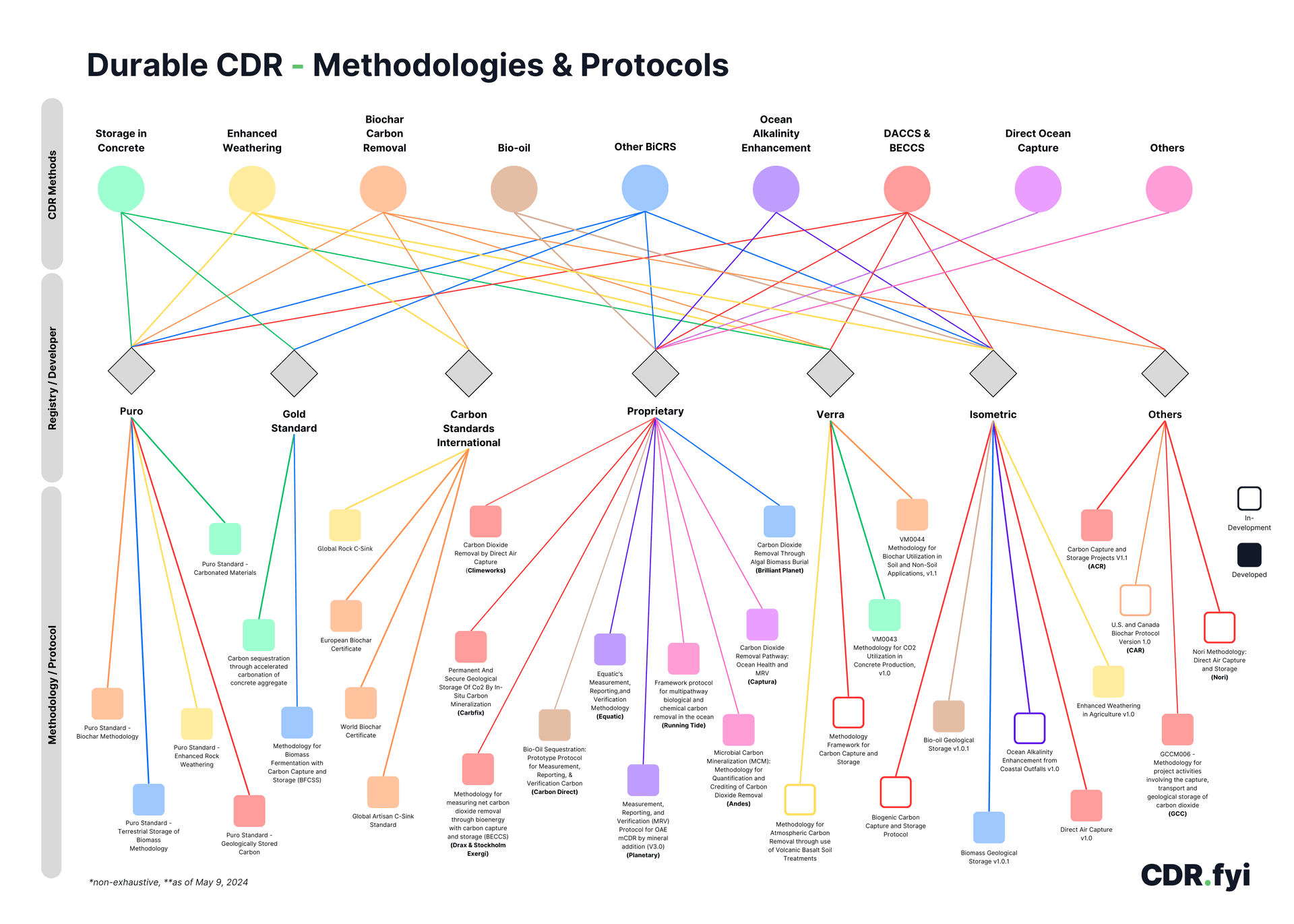May 07, 2024
Standards, Methodologies, and Protocols of Durable Carbon Removal

A post by Tank Chen & Nadine Walsh
Robust monitoring, reporting and verification (MRV) plays a pivotal role in building trust and safeguarding the integrity of carbon projects within the Voluntary Carbon Market (VCM), to the point that the term is often used as a proxy for high quality. But to what extent do these processes exist for novel carbon dioxide removal (CDR) methods?
The CDR.fyi team has identified 35 working methodologies for durable CDR and compiled them into one comprehensive overview (see below). We provide a brief outline of the terminology, and present a diagram to help visualize the current landscape of MRV methodologies and protocols in durable CDR [1] today.
In the near future, we will integrate these methodologies into the CDR.fyi data platform, enabling us to track and display the MRV frameworks that projects adhere to.
What is MRV about?
One of MRV’s principal objectives is to prove that every ton of carbon dioxide removed is truly additional and durable, that the process does no harm to the environment, and that it creates an actual climate-positive impact [2]. Additionally, robust MRV frameworks can help build greater market confidence and credibility around carbon removal activities, thus enabling the scale-up of the CDR industry and the many different methods involved through responsible deployments where the overall climate impacts are measurable and quantifiable [3].
Understanding the Basics
The terms "standard," "methodology," and "protocol" are foundational to the MRV process. In the voluntary carbon market context, they refer to related but distinct concepts that guide how carbon removal activities are quantified and verified and how carbon removal credits are issued.
- Standards: The foundation for the integrity and credibility of carbon removal activities.
A standard in the voluntary carbon market is a set of high-level principles and criteria that outline how projects should be developed, implemented, monitored and verified. It sits at the top of the hierarchy and provides the overarching framework, including non-method-specific eligibility criteria, baseline and monitoring requirements, social and environmental safeguards, community engagement, human rights issues, and verification procedures, within which projects must operate.
Carbon credit registries generally have a “standard” under which all methodologies or protocols must comply. - Methodologies: Detailed procedures within standards for accurate CDR accounting.
A methodology in the context of carbon removal is a detailed and specific set of technical procedures prescribed by a standard. It is used for establishing a baseline, setting project boundaries, monitoring, and quantifying the carbon removed by a particular type of carbon removal method. Additionally, it sets the system boundaries for quantifying any emissions associated with the carbon removal process.
A methodology is developed to be consistent with the principles and criteria outlined in the related standard to provide documentation and rules for how carbon dioxide removal activities are to be measured, monitored, reported, verified, and certified consistently and transparently. - Protocols: Specific adaptations or subsets of methodologies.
While the term protocol is essentially synonymous with “methodology” in common usage, it may or may not denotes more details and can be considered as a subset or an adaptation of the methodology or standard it falls under. It's important to note that the terminology varies among different registries, and the two terms often overlap in practice.
The Importance for Stakeholders
For suppliers, adapting the right standard and methodology is crucial for credit validity and market access. For purchasers, knowledge of these frameworks aids in assessing credit quality and alignment with organization value.
Navigating the Landscape
To help suppliers better demonstrate project integrity and purchasers gain further insights into the quality of underlying assets tracked on our platform, in the coming months, CDR.fyi will add methodologies and protocols to associated transactions where applicable. As of May 9, 2024, we have identified 35 methodologies/protocols applicable to durable carbon removal. 29 of which have been developed, and 6 of which are currently in development. 13 of these frameworks came online in the last six months.

[Download the List of Methodologies & Protocols]
The top CDR methods by the number of applicable methodologies and protocols are DACCS and BECCS, Biochar Carbon Removal, Enhanced Weathering, and a collection of other BiCRS methods.
Puro and Isometric account for about ⅓ of the total number of methodologies and protocols applicable to durable CDR methods. Puro has approved 5 methodologies, while Isometric has 3 protocols certified and 3 others currently under development. Carbon Standards International, which certifies biochar projects under its popular European Biochar Certificate methodology, has also developed 4 methodologies for durable CDR.
MRV Landscape Mapping
To illustrate the connection between CDR methods, standard bodies, and MRV protocols, we’ve created a diagram to visually map the relationships within the MRV landscape in CDR today. At the top, colored circles represent different CDR methods. Middle diamonds represent the registries or companies that have developed the methodologies and protocols, while the bottom squares show the specific protocols, with colors corresponding to the CDR methods the protocols were designed for. Colored lines connect these elements, illustrating the relationships between methods, standard bodies, and protocols. The structured overview serves as a visual reference and a practical tool for navigating the complex and dynamic landscape of MRV in durable CDR.

While the emergence of new MRV processes for durable CDR has been an important facilitator to the market’s rapid growth, there is still room for greater consistency through the efforts of the major registries. This includes both a uniform definition of CDR as well as clear minimum durability requirements. We observe that many methodologies for durable CDR methods have been developed in parallel to the ongoing efforts from the incumbent registries on the VCM, which are lagging behind in embedding these methods in their frameworks.
Recommended Readings:
- A buyer’s guide to high-accountability MRV - Carbon180
- A Guide to Certifying Carbon Removal - Carbon Gap
- A Review of Engineered Greenhouse Gas Removal Standards and Methodologies - ERM
- Tracking Greenhouse Gas Removals - Perspectives Climate Research
- Strengthening MRV standards for greenhouse gas removals to improve climate change governance - Grantham Research institute
Footnote
[1] CDR.fyi defines durable CDR as having a permanence of hundreds to thousands of years.
[2] Mercer L and Burke J, 2023
[3] Carbon Gap, 2022
Acknowledgement:
Thank you to Antti Vihavainen (Puro.earth), Chris Podgorney, Lukas May (Isometric), and Guðmundur Sigbergsson (International Carbon Registry) for reviewing and providing feedback on this post.
CDR.fyi would like to thank Antti Vihavainen (Puro.earth), Chris Podgorney, Lukas May (Isometric), and Guðmundur Sigbergsson (International Carbon Registry) for reviewing and providing feedback on this post. In addition, the authors would like to acknowledge Leo Mercer and Josh Burke for their work on the policy report "Strengthening MRV standards for greenhouse gas removals to improve climate change governance".